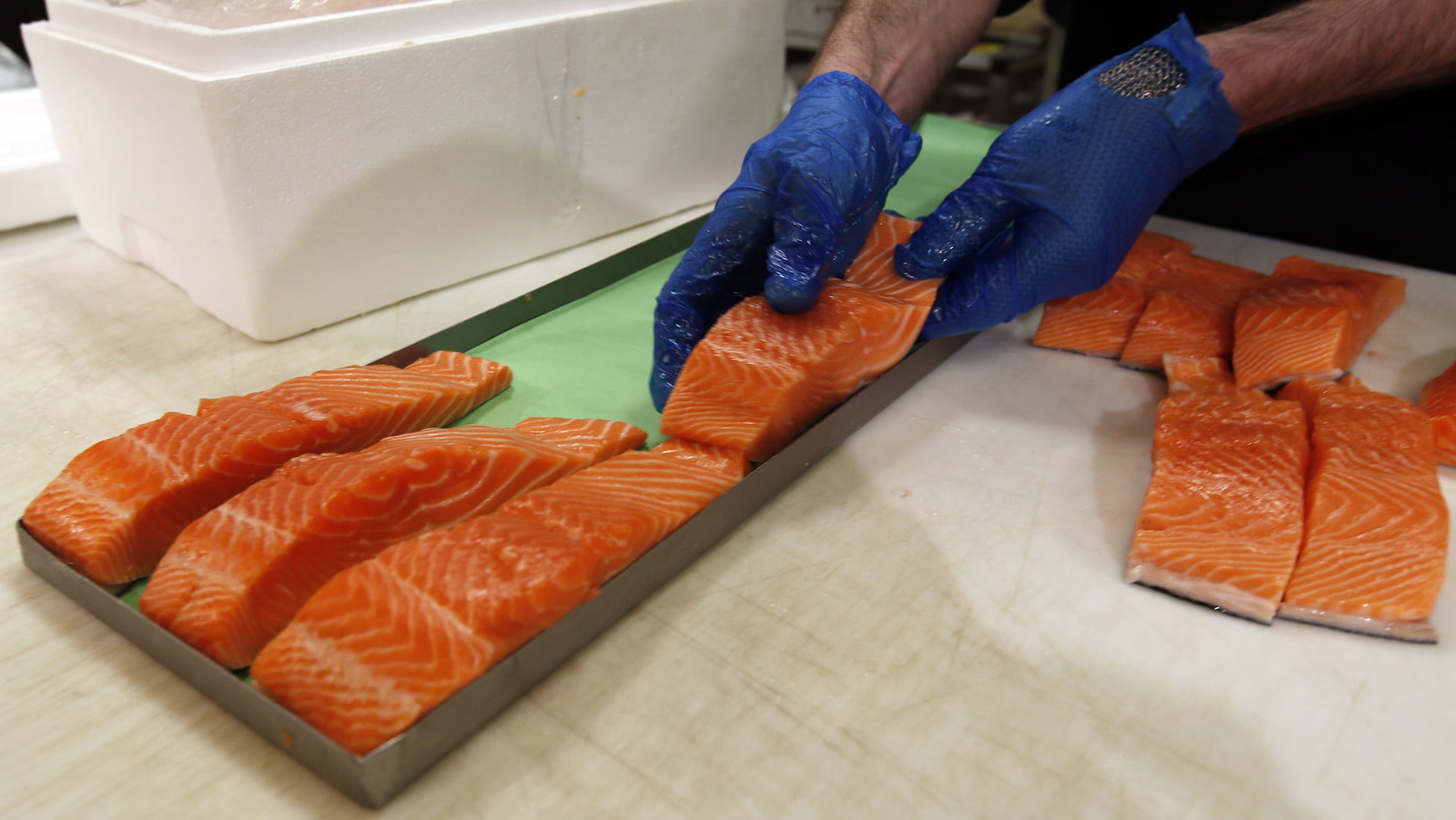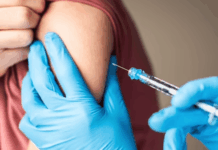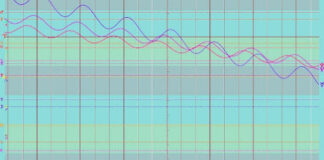
By Dr. Joseph Mercola,
STORY AT-A-GLANCE
- While fishmeal and fish oil once made up about 90% of farmed Norwegian salmon feed, research suggests that by 2016, only 10% of the fat in farmed salmon feed was marine-based
- High levels of vegetable oils, including rapeseed, or canola, are now used instead, which have had dramatic consequences for the salmon
- Significant differences were seen in cultured salmon fat cells depending on the type of fatty acid they were exposed to, including changes in the amount of mitochondria — the cells’ powerhouses — and alterations in the release of fatty acids during fasting
- The findings also suggested that oleic acid, found in vegetable oil, may promote overweight and obesity in Atlantic salmon
- An undercover investigation in Vietnam, India, and The Gambia revealed that the demand for fishmeal and fish oil used in the aquaculture industry is still fueling overfishing and putting intense pressure on wild fish stocks
Salmon is often used as an example of a health-conscious food choice, but its health value depends greatly on its source. While wild salmon is nutritious, there are many problems with farm-raised salmon, which makes up the bulk of salmon sold in U.S. supermarkets and served in restaurants.
A key part of that lies with their diet, which in the wild is made up of marine life, including zooplankton and other fish. In an attempt to simulate their wild diet, during the 1990s virtually all farmed salmon were fed diets rich in fishmeal and fish oil.1 This wasn’t sustainable, however, and in an effort to create feed for farmed fish that didn’t involve overfishing, vegetable ingredients were added as a replacement.
While fishmeal and fish oil once made up about 90% of farmed Norwegian salmon feed, by 2013 this dropped to about 30%.2 Other research suggests that by 2016, only 10% of the fat in farmed salmon feed was marine-based.3 High levels of vegetable oils, including rapeseed, or canola, are now used instead, which has had dramatic consequences for the salmon and, likely, for those who use them as a food source.
Farmed Salmon Feed Alters Cell Metabolism
Researchers from the Norwegian Institute of Food, Fisheries and Aquaculture (Nofima) conducted a study to find out how dietary changes affect the way salmon utilize fat, particularly during fasting.4 In the wild, salmon regularly experience periods of fasting when they’re unable to catch food. Farmed salmon may also fast, but only due to illnesses, spawning and prior to slaughter.5
“During these periods, it is vital for salmon to regulate fat metabolism in the body well, which is why it is interesting to study how these processes change with altered diets,” study author Bente Ruyter of Nofima explained. “This is something that is not easy to study in fish that are alive, but we can conduct a more detailed study of the energy metabolism in cultured cells.”6
Using primary fat cells isolated from 20 live fish, the researchers added fatty acids found in fish feed to determine their effects. The fatty acids included:
- Eicosapentaenoic (EPA), an omega-3 marine fat that used to be more plentiful in the feed than it is now
- Oleic acid (OA), which is found in vegetable oil and is added in higher quantities to fish feed than it was before
- Palm acid, a saturated fatty acid found in fish oil and plant oil, which has also decreased in farmed fish feed
Significant differences were seen in the cultured cells depending on fatty acid, including changes in the amount of mitochondria — the cells’ powerhouses — and alterations in the release of fatty acids during fasting.
The findings also suggested that oleic acid may promote overweight and obesity in Atlantic salmon more so than EPA and palm acid, with the researchers noting, “The supplementation of OA to mature Atlantic salmon adipocytes lead to a higher production of intracellular lipid droplets.”7
Dietary Changes Cause Significant Cellular Alterations
Changes in commercial farmed fish diets have led to significant reductions in EPA, the omega-3 fat DHA and palm acid in salmon’s adipose tissue, along with an increase in OA. These fats yield “very different and often opposing effects on central adipocyte functions,” the researchers explained, affecting adipose tissue metabolism and physiology via a number of mechanisms, including:8
- Modulating the transcript level of relevant genes
- Modifying lipolytic activity
- Modulating metabolic processes, such as lipid droplet formation, the leptin system and mitochondrial dynamics
It was formerly believed that salmon transport fat as free fatty acids, including during sexual maturation, when nutrients from fat tissue are transferred to reproductive cells. The study revealed, however, that the fat is transported on phospholipids, cholesterol esters and triglycerides.9
Correlations were also seen with humans, as the salmon fat cells reacted to fasting similarly to human fat tissue.
“Many of the regulatory mechanisms associated with energy metabolism when on a fatty diet appear to be similar to those found in humans,” according to Nofima.10 The researchers suggested that more research is needed to find out how the lipid composition of fat cells affects fish physiology and health, especially during fasting.
When a fish stops eating, the ability to recruit lipids from fat cells is essential for reproduction as well as recovery from disease, making the dietary changes potentially disastrous. What’s more, it could also serve as a warning for humans. According to Nofima scientist Marta Bou Mira:11
“In this journal, most research focuses on humans, but I think salmon is increasingly being considered as a possible model for humans. We have conducted basic research on fish that has never been done before, and the combination between adipose tissue models and an increased understanding of obesity-related issues most likely caught people’s eye.”
How Does Eating Farmed Salmon Affect Humans?
If you eat farmed salmon, you’re essentially consuming the salmon’s unnatural diet as well. In a review published in the Journal of Experimental Biology, Nini Sissener with the Institute of Marine Research in Norway looked into how changes in commercial salmon feed affect the fatty acid composition of salmon tissues, and how these changes affect the humans who eat them, essentially following the fatty acids through the food chain.12
Salmon is the second most popular type of seafood in the U.S. (shrimp is the first), with just over 2 pounds consumed annually, per person.13 A key reason behind its popularity has to do with its perceived health benefits. As a rich source of beneficial animal-based omega-3 fats, salmon can, indeed, be a very healthy food choice.
While farmed salmon may still provide a source of omega-3 fats, the concentrations are less than they were before, however, and are less than those found in wild salmon.
“Farmed salmon still contributes positively to the overall n-6/n-3 ratio of a Western diet, but to a much lesser extent than before,” Sissener wrote. “Combined with similar changes in much of our food supply, this is a cause for concern, and efforts should be made to limit the amount of n-6 FAs in salmon fillets.”14
Farm-raised salmon makes up 75% of the salmon consumed worldwide, and its volume has increased nearly 1,000% from 1990 to 2015,15 which means that changes in its nutritional content may affect public health.
While half a fillet of wild Atlantic salmon contains about 3,996 milligrams (mg) of omega-3 and 341 mg of omega-6,16 the same amount of farmed Atlantic salmon contains an astounding 1,944 mg of omega-6.17 Aside from an inferior nutritional profile, farmed salmon is also more likely to contain toxins.
Consuming Atlantic Farmed Salmon May Pose Health Risks
The Environmental Working Group (EWG) tested farmed salmon from U.S. grocery stores and found farmed salmon had, on average:18
- 16 times more polychlorinated biphenyls (PCBs) than wild salmon
- Four times more PCBs than beef
- 3.4 times more PCBs than other seafood
What’s more, in 2005 researchers found that farmed Atlantic salmon were so contaminated with PCBs, toxaphene, dieldrin, dioxins and polybrominated diphenyl ethers that they posed a cancer and additional health risks to humans, even when consumed in moderate amounts:19
“Many farmed Atlantic salmon contain dioxin concentrations that, when consumed at modest rates, pose elevated cancer and noncancer health risks.
However, dioxin and DLCs [dioxin-like compounds] are just one suite of many organic and inorganic contaminants and contaminant classes in the tissues of farmed salmon, and the cumulative health risk of exposure to these compounds via consumption of farmed salmon is likely even higher.
As we have shown here, modest consumption of farmed salmon contaminated with DLCs raises human exposure levels above the lower end of the WHO TDI [World Health Organization’s tolerable daily intake], and considerably above background intake levels for adults in the United States.”
27% of Wild-Caught Fish Fed to Fish
The environmental risks of farm-raised salmon must not be overlooked, and while feeding farmed salmon a diet more comparable with what they would eat in the wild may be preferable from a nutritional standpoint, it’s not a sustainable solution.
About 27% of wild-caught fish — amounting to about 20 million tons of seafood — is used to make fishmeal that’s fed to farmed fish,20 and stocks of wild fish may be dwindling as a result.
An undercover investigation in Vietnam, India and The Gambia by the Changing Markets Foundation, titled “Fishing for Catastrophe,” also revealed that the demand for fishmeal and fish oil used in the aquaculture industry is fueling overfishing and putting intense pressure on wild fish stocks.21 According to the report:22
“Our findings show that FMFO [fishmeal and fish oil] production, driven by demand from the global aquaculture sector, is visibly accelerating the decline of fish stocks in India, Vietnam and The Gambia that marine fisheries for human consumption have already pushed to breaking point.
Local fisherpeople and communities are clear-eyed about the consequences for them; they see the slump in catches they are currently experiencing as a precursor to the inevitable destruction of the fisheries that sustain them. However, they feel powerless against the economic might of the industry.”
While 90% of the fish being used for fishmeal and other uses could be used to feed humans directly,23 they’re instead being diverted into other uses, contributing to food insecurity in local communities. Further, as noted in “Fishing for Catastrophe:”24
“A report published in July 2019 found that the Scottish salmon industry alone uses roughly the same quantity of wild-caught fish to feed its salmon as the entire adult population of the UK purchases in one year, and that it will require a further 310,000 tonnes of wild fish per year to meet its ambitions to double in size by 2030.”
Safer, Sustainable Seafood Options
With fishmeal and fish oil representing an unsustainable feed source, and plant-based feed alternatives leading to changes in farmed salmon’s cellular metabolism and nutritional value, eating farm-raised salmon is not advisable.
I only recommend eating safer seafood choices such as wild-caught Alaskan salmon, sardines, anchovies, mackerel and herring. All of these are at low risk of contamination yet are high in healthy omega-3 fats. You’ll want to opt for sustainably harvested wild-caught fish as well.
One of the best options toward this end is to look for the Marine Stewardship Council (MSC) logo, which features the letters MSC and a blue check mark in the shape of a fish. The MSC logo ensures the seafood came from a responsible fishery that uses sustainable fishing practices to minimize environmental impacts.25
Disclaimer: We at Prepare for Change (PFC) bring you information that is not offered by the mainstream news, and therefore may seem controversial. The opinions, views, statements, and/or information we present are not necessarily promoted, endorsed, espoused, or agreed to by Prepare for Change, its leadership Council, members, those who work with PFC, or those who read its content. However, they are hopefully provocative. Please use discernment! Use logical thinking, your own intuition and your own connection with Source, Spirit and Natural Laws to help you determine what is true and what is not. By sharing information and seeding dialogue, it is our goal to raise consciousness and awareness of higher truths to free us from enslavement of the matrix in this material realm.
 EN
EN FR
FR


























The war on Food.
The war on Health.
What next?
Get chipped!
They gotcha!
Im fortunate to live in a Big AG area and I buy alot of food direct from farms.
IF you have access to Yak meat, I would highly recommend it.
Its very nutritious and very high in Omega oils.
I get their fiber from my local Yak Rancher too and we needle felt the wool.
The Yaks are amazingly gentle creatures.
Thank you. I have been aware of the health problems created by farmed fish for sometime and do not eat fish (or meat or dairy products, except organic plain yogurt).
Add to the problems created by the use of the wrong vegetable oils (a word used to not revealing what oils were used, including canola oil – very, very bad) the oils are cooked twice, before purchase (to prevent spoilage) and when the fish is cooked, destroying all digestive enzymes. Canola oil is a very heavy oil that was NEVER intended to be eaten by animals, fish or humans. Between margarine and canola oil, the heart doesn’t have a chance. It frustrates me to see that canola oil and soy beans are used in the health food industry. Organic or not, neither should be eaten by humans or animals. Soy destroys the function of the pancreas that protects us from cancer cells. (Another dark forces’ agenda humans have fallen for!)
For a while I was working in the ‘home health care’ industry and was sent to the hospital to assist a wife take her doctor husband – a heart specialists – to the motel room where they were staying. The hospital put a pacemaker in his heart (bad news, to begin with they don’t work, the surgery taxes the body and the drugs given destroy the immune system). His wife and I had to help him to do everything. When we changed his diapers, I learned that the blood in his gonads was not returning to his heart because they were extremely swollen. Needless to say, he was in great pain. The pain pills create more problems. He was given the same toxic drugs he had been giving to his patients over the years. How sad they trusted him with their health. Pay back, he was In shock from the wake-up call. His energies were heavy and dark. I felt sorry for his wife who was forced to spend the rest of her life taking care of a man who did not take care of himself but believed the lies he was programmed with by the pharmaceutical industry that feed his ego and pockets.
The lesson? Listen to and trust what our bodies and Higher More Noble Selves are telling us or pay he price.